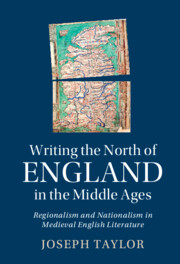 Writing the North of England in the Middle Ages
Writing the North of England in the Middle Ages Published online by Cambridge University Press: 08 December 2022
Chapter 3 examines the phenomenon of “nations” at the medieval English universities, that is, the means by which students were segregated as northern or southern within the colleges at Oxford and Cambridge (determined by whether they hailed from North or South of the Trent), and these distinctions of provenance were based on the models at Bologna and Paris. This chapter demonstrates several instances of marked violence between the “nations” at Oxford and Cambridge, focusing primarily on the Stamford Schism of the early-1330s wherein several northern students fled Oxford, under persecution, for a studium at Stamford (Lincolnshire) where they engaged an extant learning community. King Edward III recognized the threat posed to England’s universities by such flight and he moved quickly to settle the matter. The intense rivalries in the Schism are evident in two overlooked Latin poems written by students during the conflict, which this chapter analyses. The proceeding years of negotiation to end the Schism illustrate the importance of the universities to England’s burgeoning nationalism and, thus, the role that the North–South divide played in it.
To save this book to your Kindle, first ensure [email protected] is added to your Approved Personal Document E-mail List under your Personal Document Settings on the Manage Your Content and Devices page of your Amazon account. Then enter the ‘name’ part of your Kindle email address below. Find out more about saving to your Kindle.
Note you can select to save to either the @free.kindle.com or @kindle.com variations. ‘@free.kindle.com’ emails are free but can only be saved to your device when it is connected to wi-fi. ‘@kindle.com’ emails can be delivered even when you are not connected to wi-fi, but note that service fees apply.
Find out more about the Kindle Personal Document Service.
To save content items to your account, please confirm that you agree to abide by our usage policies. If this is the first time you use this feature, you will be asked to authorise Cambridge Core to connect with your account. Find out more about saving content to Dropbox.
To save content items to your account, please confirm that you agree to abide by our usage policies. If this is the first time you use this feature, you will be asked to authorise Cambridge Core to connect with your account. Find out more about saving content to Google Drive.